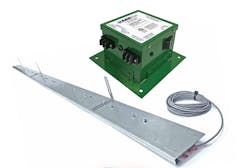As the United States enters late fall and the weather grows colder, the COVID-19 pandemic continues to spread as Americans congregate in larger numbers indoors. And since scientists believe that the SARS-CoV-2 coronavirus is spread through aerosolized particles and that those particles can hang in the air for an extended period, HVAC professionals continue to look for technological methods of controlling the disease's spread inside buildings.
One such technology is bipolar ionization (BPI), also called needlepoint bipolar ionization. This indoor air quality method involves air cleaners installed in HVAC systems to create reactive ions or reactive oxygen species (ROS) in the air, which react with airborne contaminants such as viruses.
Since a virus cannot survive without a hydrogen bond, bipolar ionization is said to neutralize the pathogen and remove it from the air via an electrostatic force.
An electric charge creates a plasma field filled with positive and negative ions. The ions fuse along the surface of a virus and capture a hydrogen bond. Since a virus cannot survive without a hydrogen bond, bipolar ionization is said to neutralize the pathogen and remove it from the air via an electrostatic force.
The air-cleaning technology has been around for decades and is used in hospitals, schools, hotels, airports, government buildings, sports arenas, office buildings and residences. Advanced BPI technology allows for particle reduction and pathogen control in the air and on surfaces, and a possible method of controlling SARS-CoV-2 in buildings. There is even some evidence to suggest that cleaning indoor air and recirculating it can reduce outdoor intake rates and conserve energy.
The efficacy of bipolar ionization is still under review at ASHRAE.
However, the efficacy of bipolar ionization is still under review at ASHRAE. “Convincing scientifically rigorous, peer-reviewed studies do not currently exist on this emerging technology; manufacturer data should be carefully considered,” the organization notes on its website. “Systems are reported to range from ineffective to very effective in reducing airborne particulates and acute health symptoms.”
The biggest caveat to using such systems is the potential for the equipment to create ozone as a byproduct of the process. However, the Centers for Disease Control and Prevention notes that BPI has matured and many of its “earlier potential safety concerns are now resolved.” Yet, BPI is still considered an “emerging” technology as it has a “less-documented track record in regards to cleaning/disinfecting large and fast volumes of moving air within heating, ventilation, and air conditioning systems.”
The Centers for Disease Control and Prevention notes that BPI has matured and many of its “earlier potential safety concerns are now resolved.”
To ensure that HVAC professionals offer the right BPI solution for clients’ applications, the CDC recommends researching the technology. The equipment must meet UL Standard 2998, Environmental Claim Validation Procedure for Zero Ozone Emissions from Air Cleaners, which is intended to validate that no harmful ozone levels are produced.
“Match any specific claims against the consumer’s intended use,” the CDC recommends. “Consumers should request efficacy performance data that quantitively demonstrates a clear protective benefit under conditions consistent with those for which the consumer [intends] to apply the technology. Preferably, the documented performance data under as-used conditions should be available from multiple sources, some of which should be independent, third-party sources.”
So, is bipolar ionization effective in eliminating the virus that causes COVID-19? There is evidence to suggest it does. However, building owners and employers should still encourage frequent handwashing, social distancing, and the use of face coverings and hand sanitizer for occupants. And the bipolar ionization process should be accompanied by regular cleaning of high-traffic areas.
About the Author

Kelly L. Faloon
Freelance Writer/Editor
Kelly L. Faloon is a contributing editor and writer to Contracting Business magazine, Contractor and HPAC Engineering. The former editor of Plumbing & Mechanical magazine, Faloon has more than 20 years experience in the plumbing and heating industry. She started a freelance writing and editing business in 2017, where she has a varied clientele.
Faloon spent 3 1/2 years at Supply House Times before joining the Plumbing & Mechanical staff in 2001. Previously, she spent nearly 10 years at CCH/Wolters Kluwer, a publishing firm specializing in business and tax law, where she wore many hats — proofreader, writer/editor for a daily tax publication, and Internal Revenue Code editor.
A native of Michigan’s northern Lower Peninsula, Faloon is a journalism graduate of Michigan State University. You can reach her at [email protected].
